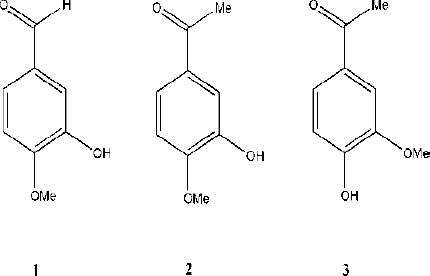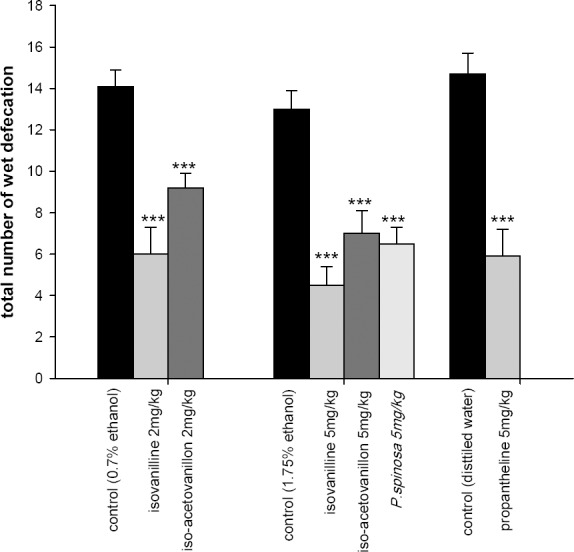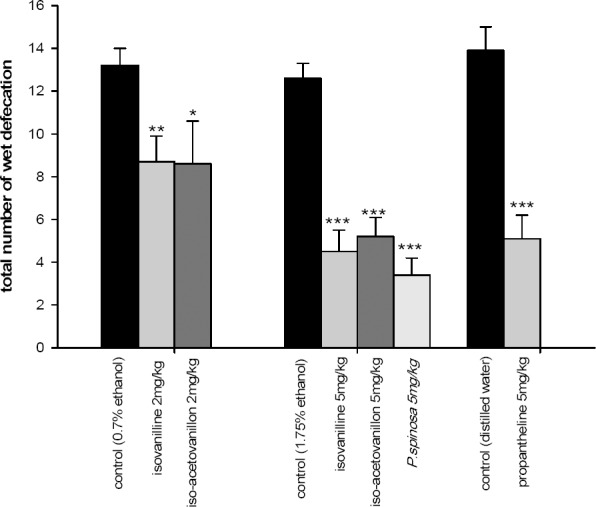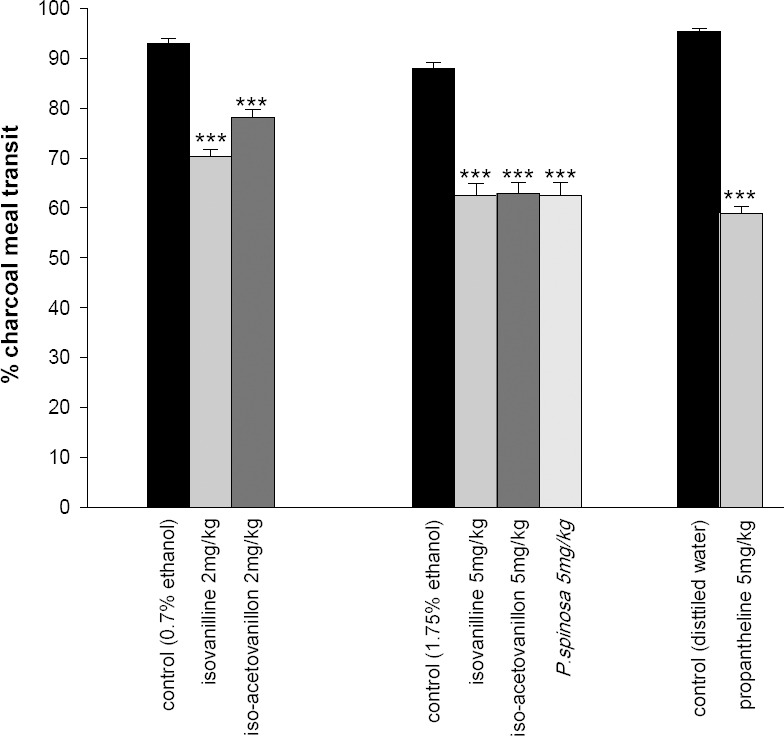Abstract
Isovanillin and iso-acetovanillon are two phenolic components isolated from a number of plants including Pycnocycla spinosa. P. spinosa extract has antispasmodic and antidiarrheal activities. However, no comparative study has been done on antidiarrheal action of isovanillin and iso- acetovanillon, so far. The aim of this study was to investigate antidiarrheal action of isovanillin and iso-acetovanillon and their effects on small intestinal transit, for comparison with propantheline. Male mice (25-30 g), fasted over night with free access to water, were treated with test compounds or control (p.o.). Thirty min later castor oil (0.5 ml) was given orally to the animals. In another groups of animals MgSO4 (0.5 ml of 10% solution) was given first and half an hour later the test drugs were administered. Onset and number of wet defecations were recorded for each animal over 3.5 h after treatment with diarrhoea inducing agents. In another groups, intestinal transit of charcoal meal was determined following administration of the compounds. Isovanillin (2 mg/kg & 5 mg/kg), iso-acetovanillon (2 mg/kg & 5 mg/kg) and P. spinosa extract (5 mg/kg) delayed onset of diarrhoea and significantly reduced wet defecation induced by castor oil and MgSO4. They all had antidiarrheal effect similar to propantheline (5 mg/kg). Isovanillin, iso-acetovanillon and P. spinosa extract compared to control groups, significantly reduced small intestinal transit of charcoal meal. This study shows that antidiarrheal effect of P. spinosa extract is at least partially due to presence of two active compounds isovanillin and iso-acetovanillon.
Keywords: Isovanillin, Iso-acetovanillon, Propantheline, Ileum transit, Pycnocycla spinosa extract, Diarrhoea
INTRODUCTION
Plant extracts have been used as a remedy over centuries and many clinically useful drugs had been derived form plant materials (1). Many plant derived remedies are traditionally being administered to treat diseases associated with digestive tract movement. Diarrhoea is a common disease of tropical areas and responsible for mortality of children and infants (2). The World Health Organisation also has emphasis on the use of traditional medicine in the control and management of diarrhoea (2).
Pycnocycla spinosa, a native plant of Iran (1,3) with antispasmodic and antidiarrheal activities (4,5,6,7), could be a suitable candidate. Using chromatography separation techniques, potent fractions have been separated from the crude extract of this plant (6,8). Further researches had led to the identification of bioactive phenolic compounds (9). Plant derived phenolic compounds like benz-aldehyde, and benzyl alcohol have showen antispasmodic activity and some of them like piperonal or vanillin possess this action in higher degree and could be considered as suitable candidates (10,11). Also, mebeverine, as a standard antispasmodic drug (12) is derived from vanillin or its derivatives. Isovanillin as a phenolic aldehyde (Fig. 1), found in a number of plants (13,14,15,16), is a selective inhibitor of aldehyde oxidase and is metabolized by aldehyde dehydrogenase into isovanillic acid (17,18). Despite many reports on its related isomer vanillin, however, there isn’t any official report on isovanillin pharmacological action on gastrointestinal function. Acetovanillon (apocynin) is also a natural organic compound structurally related to vanillin. It has been isolated from a variety of plant sources and is being studied for its different pharmacological properties. It is used for its known effectiveness against edema and heart problems (19).
Fig. 1.

Structure of isovanillin (1), iso-acetovanillon (2) and acetovanillon (3).
Acetovanillon was also found in Picrorhiza kurroa, a small plant that grows at high altitudes in the western Himalayas (20). P. kurroa has been used for many years for the treatment of liver disease, heart problems, jaundice and asthma (20). Acetovanillon anti-inflammatory capabilities proved to be a result of its ability to selectively prevent the formation of free radicals, oxygen ions and peroxides in the body (21,22).
Iso-acetovanillon (Fig. 1) is also found in a number of plant materials (23) but its pharmacological effects are not well documented except for a short report about analgesic and low antibacterial activity against Escherichia coli and Shigella flexneri (23). Chinese scientists also reported that iso-acetovanillon had inhibitory action on the gastrointestinal motility (23) with no given details. Therefore, the objective of this research was to investigate antidiarrheal effects of isovanillin and iso-acetovanillon as well as reducing intestinal motility in an animal model.
MATERIALS AND METHODS
Plant materials
Aerial parts of P. spinosa were collected in June (2011) from Isfahan University campus and identified. A voucher specimen (A 24) was authenticated and then deposited in the herbarium of the School of Pharmacy and Pharmaceutical Sciences (Isfahan, Iran). The aerial part of the plant was dried in shade. The total hydroalcoholic extract was obtained using percolation (24). After evaporating the ethanol, the amount of dry crude extract was determined (10 % w/w).
Antidiarrheal studies
Drugs and solutions
The following drugs were used in this study: Iso-acetovanillon (Sigma), isovanillin (Sigma), propantheline (Sigma) and hydroalcoholic extract of P. spinosa.
Isovanillin, iso-acetovanillon and extract of P. spinosa were initially made up as 10 mg/ml stock solution in 70% ethanol and then diluted with distilled water as 250 μg/ml and 100 μg/ml for oral administration. Propantheline was made up in distilled water as 2.5 mg/ml and further diluted with distilled water as 250 μg/ml for oral use. MgSO4 (Merck) was made up as 10% solution in distilled water. Charcoal (3%) and tragacanth (5%) suspensions were prepared in distilled water. The stock solutions were prepared in such a way that about 0.5 ml of the solution contained the appropriate dose of each drug.
Pharmacological studies
Male albino mice bred (25-30 g) in Isfahan School of Pharmacy and Pharmaceutical Sciences animal house was used for the experiments. They were kept at room temperature in accordance with the inter-nationally accepted principles for laboratory animal use and care, as recommended by university authority (25) and fasted overnight prior to the experiments with free access to water.
In this study antidiarrheal effect of two components of P. spinosa extract were assessed on castor oil and MgSO4 induced diarrhea and compared to that of hyroalcoholic extract. In addition, effect of these substances on ileum movement was assessed using charcoal meal transit test. The following doses of drugs were examined: iso-acetovanillon (2 mg/kg and/or 5 mg/kg), isovanillin (2 mg/kg and/or 5 mg/kg), propantheline (5 mg/kg) and hydroalcoholic extract of P. spinosa (5 mg/kg). In addition, equivalent volume of vehicle was used in the control groups. All the drugs were given orally to each mice using special metallic feeding needle for mice.
Castor oil induced diarrhoea
Test compounds or vehicle were given orally to groups of 10 mice. 30 min later, diarrhoea was induced by oral administration of 0.5 ml castor oil (Dine Company, Iran). Then each mouse placed under a large glass funnel and number of wet defecation on tissue paper was recorded over 3.5 h.
Magnesium sulphate induced diarrhoea
Diarrhoea was induced by oral administration of MgSO4 solution (2 g/kg) and half an hour later, test compounds or vehicles were given intragastrically to the animals and incidence of diarrhoea was assessed as mentioned before.
Charcoal meal transit test
In this test, movement of charcoal meal in the intestine was assessed. For this purpose each test drug was given orally to mice and 30 min later 0.5 ml of charcoal meal containing 3% charcoal and 5% tragacanth suspension was administered orally. One hour after charcoal meal administration, each animal was killed and distance of charcoal movement was measured.
Measurement and statistical analysis
Number of wet defecation over the course of study was used for the assessment of diarrhoea index. Ileum transit was expressed as percentage of charcoal moved from pylorus to caecum relative to whole length of the ileum. All results were expressed as mean ± standard error of mean (SEM) and compared with corresponding vehicle treated control group using unpaired Student's t-test.
RESULTS
Castor oil induced diarrhoea
In the vehicle treated control groups within 1.5 h after administration of castor oil, all the animals had shown signs of diarrhoea. The diarrhoea peaked 2 h after treatment and then gradually subsided down. Propantheline (5 mg/kg) had inhibitory effect on castor oil induced diarrhoea, reducing the incidence of diarrhoea by 60% (Fig. 2) with one animal showing no sign of diarrhoea. Hydroalcoholic extract of P. spinosa (5 mg/kg) in comparison with the control group reduced the incidence of diarrhoea by 50% (Fig. 2). One animal in this group had no sign of diarrhoea. Isovanillin (2 mg/kg and 5 mg/kg) in a dose dependent manner reduced castor oil induced diarrhoea by 58% and 66%, respectively (Fig. 2). In these groups, altogether 4 animals had no diarrhoea and the incidence of diarrhoea was reduced in the rest of animals. Iso-acetovanillon (2 mg/kg and 5 mg/kg) similarly reduced the incidence of diarrhoea by 35%, and 46% (Fig. 2) with one animal without diarrhoea.
Fig. 2.

Antidiarrheal activity of P. spinosa hydroalcoholic extract, isovanillin, iso-acetovanillon and propantheline on mice with castor oil induced diarrhoea (0.5 ml. p.o.) in comparison with that of corresponding vehicle treated controls. Incident of diarrhoea were assessed as number of wet defecation following castor oil administration. Data are mean ± SEM, n=10 for each group. ***P<0.001 in comparison with corresponding vehicle treated control group (Student's t-test).
Magnesium sulphate induced diarrhoea
An hour after orally administration of MgSO4, signs of diarrhoea were observed in the animals and the peak of diarrhoea was achieved within 1.5 h before it gradually subsided down. Propantheline significantly reduced the incidence of diarrhoea by 64% with one animal without wet defection during the study (Fig. 3). P. spinosa extract (5 mg/kg) also reduced the incidence of diarrhoea by 73% (Fig. 4). Furthermore, there was a significant delay in induction of diarrhoea (Table 1). Iso-acetovanillon (2 mg/kg, and 5 mg/kg) significantly reduced the number of wet defecation by 35% and 59%, and isovanillin (2 mg/kg, and 5 mg/kg) by 35%, and 64%, respectively (Fig. 3) with one animal in each case showing no sign of diarrhoea.
Fig. 3.

Antidiarrheal activity of P. spinosa hydroalcoholic extract, isovanillin, iso-acetovanillon and propantheline on mice with MgSO4 induced diarrhoea (0.5 ml, 10% solution) in comparison with that of corresponding vehicle treated controls. Incident of diarrhoea were assessed as number of wet defecation following MgSO4 administration. Data are expressed as mean ± SEM, n=10 for each group. *P<0.05, ***P<0.001 in comparison with corresponding vehicle treated control group (Student's t-test).
Fig. 4.

Effect of P. spinosa hydroalcoholic extract, isovanillin, iso-acetovanillon and propantheline on small intestinal transit (0.5ml of charcoal meal) in comparison with that of corresponding vehicle treated controls. Gastrointestinal transit was expressed as the percentage of distance that charcoal moved relative to whole length of small intestine over an hour. Data are mean ± SEM, n=10 for each group. ***P<0.001 in comparison with corresponding vehicle treated control group (Student's t-test).
Table 1.
Time of induction of diarrhoea after administration of laxatives in control and treatment groups.

Charcoal meal transit test
In the control group one hour after charcoal feeding, the black meal moved up to 90-95% of the ileum length. All the tested compounds significantly reduced the distance moved by the charcoal meal (Fig. 4). The inhibitory effects of isovanillin (5 mg/kg) and iso-acetovanillon (5 mg/kg) on charcoal transit of ileum were similar to that of propantheline (5 mg/kg). P. spinosa extract (5 mg/kg) had similar inhibitory effect on charcoal meal ileum transit (Fig. 4).
DISCUSSION
Isovanillin and iso-acetovanillon are two components of P. spinosa extract with relaxant effect on rat isolated ileum (26). P. spinosa extract have been shown to have antidiarrheal activity in mice (4,7) however, antidiarrheal effects of these two compounds have not yet been studied previously. In the current study, we have used castor oil and MgSO4 for inducing diarrhoea in mice to examine antidiarrheal effects of isovanallin and iso-acetovanillon in comparison with that of propantheline as a standard drug. In addition, gut transit was also assessed to check if these compounds have any effect on gastrointestinal transit time. Laxatives generally act by enhancing retention of intraluminal fluid, decreasing net absorption of fluids by effects on small and large bowel fluids and electrolyte transport or altering motility by either inhibiting non-propulsive contraction or stimulating propulsive contraction (27). MgSO4 is an osmotic laxative and prevents water absorption from gut and cause diarrhoea by creating osmotic pressure (27). Castor oil contains two known ingredient ricin and a triglyceride of ricinoleic acid. The triglyceride hydrolysed in the small intestine by the action of lipase enzyme into glycerol and the active agent, ricinoleic acid, which acts primarily in the small intestine to stimulate secretion of fluids and electrolytes and speed up intestinal transit (27).
Propantheline had a similar inhibitory effect on castor oil and MgSO4 induced diarrhoea (Fig. 2, and Fig. 3). Similarly, propantheline was effective in reducing the gastrointestinal transit time (Fig. 4). In MgSO4 study, antidiarrheal effect of P. spinosa extract was slightly better than that of propantheline at equal doses. In addition P. spinosa extract delayed induction of diarrhoea in MgSO4 induced diarrhoea. This may indicate that in addition to antispasmodic effect, the extract also affects electrolyte secretion in the gut. At equal doses, antidiarrheal effects of isovanillin and iso-acetovanillon were relatively similar and were comparable with that of propantheline at 5 mg/kg doses. Again, at similar oral doses when the effect of these active compounds was compared with that of the standard drugs, their pharmacological effects were similar to the effect of propan-theline. Propantheline is an antispasmodic agent which acts by blocking muscarinic receptors on smooth muscles and reduces gastrointestinal secretion from epithelial cells and is used for symptomatic relief of gastrointestinal disorders characterised by smooth muscle spasm (12,27,28). Anti-spasmodic effects of 4-hydroxy-3-methoxy-phenyl class compounds like vanillin and curcumins have already been reported (10,29). Rosmarinic acid and caffeic acid belong to another category, 3,4-dihydroxy-phenyl class compounds which have a non-specific antispasmodic action on smooth muscle in several isolated rat organs (30). Mebeverine, related to 3,4-dimethoxyphenyl class compounds, is known as an antispasmodic drug (27,31). In addition, coumarin like osthole has antispasmodic activity (32,33). To the best of our knowledge, it is the first report about 3-hydroxy-4-methoxyphenyl class compounds like isovanillin and iso-acetovanillon to have antidiarrheal and anti- motility effect on gastrointestinal tract. Mechanism of action of isovanillin and iso-acetovanillon on gastrointestinal tract is not known but reduction of charcoal transit time indicates that they reduce ileum motility. However, there are some pharmacological similarities between vanillin and isovanillin. For instance, vanillin is a substrate for aldehyde oxidase while isovanillin is an inhibitor of aldehyde oxidase (34). In the same manner, the pharmacological activity of iso-acetovanillon may be similar to that of acetovanillon which has some degrees of anti-inflammatory effects (21). However, exact mechanism of action of these compounds should be investigated.
CONCLUSION
Isovanillin and iso-acetovanillon are two active components which are present in P. spinosa extract and both have antidiarrheal and anti-motility effect on gastrointestinal tract. Although these two compounds have significant contribution to antidiarrheal activity of the P. spinosa extract but other constituents may have contribution which needs to be investigated.
ACKNOWLEDGMENTS
This paper is part of Niloofar Azali theses submitted in partial fulfillment of the requirements for the degree of. Pharm D (NO: 190104). We are also grateful to the Isfahan Pharmaceutical Sciences Research Center, Isfahan University of Medical Sciences, Isfahan, for the financial support.
REFERENCES
- 1.Mozaffarian V. Tehran: Farhng Moaser; 1996. A dictionary of Iranian plant names; pp. 443–444. [Google Scholar]
- 2.Syder JH, Merson MH. The magnitude of the global problem of acute diarrheal disease: a review of active surveillance data. Bull WHO. 1982;60:605–613. [PMC free article] [PubMed] [Google Scholar]
- 3.Jalili A, Jamzad Z. Tehran: Research Institute of Forests and Rangelands; 1999. Red data book of Iran, A preliminary survey of endemic, rare and endangered plant species in Iran; pp. 689–690. [Google Scholar]
- 4.Sadraei H, Asghari G, Naddafi A. Relaxant effect of essential oil and hydro-alcoholic extract of Pycnocycla spinosa Decne. ex Boiss. on ileum contractions. Phytother Res. 2003;17:645–649. doi: 10.1002/ptr.1217. [DOI] [PubMed] [Google Scholar]
- 5.Sadraei H, Asghari G, Hekmatti AA. Antispasmodic effect of three fraction of hydroalcoholic extract of Pycnocycla spinosa. J Ethnopharmacol. 2003;86:187–190. doi: 10.1016/s0378-8741(03)00077-1. [DOI] [PubMed] [Google Scholar]
- 6.Sadraei H, Asghari G, Khazael M. Relaxant effect of four fractions separated from alkaloid extract of Pycnocycla spinosa on rat isolated ileum. Res Pharm Sci. 2008;3:79–86. [Google Scholar]
- 7.Sadraei H, Asghari G, Shams M. Antidiarrheal action of hydroalcoholic extract of Pycnocycla spinosa in comparison with loperamide and dicyclomine. Iranian J Pharm Res. 2011;10:835–841. [PMC free article] [PubMed] [Google Scholar]
- 8.Sadraei H, Asghari G, Behzad S. Bioactivity-guided isolation of spasmolytic components of Pycnocycla spinosa Decne ex Boiss. Res Pharm Sci, 2011;6:81–86. [PMC free article] [PubMed] [Google Scholar]
- 9.Jahed M. Pharm D [Thesis] Isfahan University of Medical Sciences; 2013. Quantitative comparison of anti-spasmodic action of fractions separated from Pycnocycla spinosa extract on rat ileum using a bioassay technique. [Google Scholar]
- 10.Shonle HA, Row PQ. New benzyl esters possessing an anti-spasmodic action. J Am Chem Soc. 1921;3:361–365. [Google Scholar]
- 11.Vidal JP. Kirk-Othmer Encyclopedia of Chemical Technology. Wiley Online Library. 2006. http://dx.doi.org/10.1002/0471238961.2201140905191615.a01.pub2 .
- 12.Rang HP, Dale MM, Ritter JM, Flower RJ. 6th ed. London: Churchill Livingstone Elseveire; 2007. The gastrointestinal tract (chapter 25).In Rang & Dale's Pharmacology; pp. 385–396. [Google Scholar]
- 13.Yang L, Feng F, Gao Y. Chemical constituents from herb of Solanum lyratum. Zhongguo Zhong Yao Za Zhi. 2009;34:1805–1808. [PubMed] [Google Scholar]
- 14.Xu J, Tan N, Zeng G, Han H, Huang H, Ji C, et al. Studies on chemical constituents in fruit of Alpinia oxyphylla. Zhongguo Zhong Yao Za Zhi. 2009;34:990–993. [PubMed] [Google Scholar]
- 15.Chen W, Tang S, Qin N, Zhai H, Duan H. Antioxidant constituents from Smilax riparia. Zhongguo Zhong Yao Za Zhi. 2012;37:806–810. [PubMed] [Google Scholar]
- 16.Khaliq-uz-Zaman SM, Simin K, Ahmad VU. Chemical constituents from Asparagus dumosus. Fitoterapia. 2000;71:331–333. doi: 10.1016/s0367-326x(99)00154-9. [DOI] [PubMed] [Google Scholar]
- 17.Lee K, Park SK, Kwon BM, kim K, Yu HE, Ryn J, et al. Transport and metabolism of the antitumour drug candidate 2´-benzoyloxycinnamaldehye in Caco-2 cells. Xenobiotica. 2009;39:881–888. doi: 10.3109/00498250903216000. [DOI] [PubMed] [Google Scholar]
- 18.Panoutsopoulos GI, Beedham C. Metabolism of isovanillin by aldehyde oxidase, xanthine oxidase, aldehyde dehydrogenase and liver slices. Pharmacol. 2005;73:199–208. doi: 10.1159/000082860. [DOI] [PubMed] [Google Scholar]
- 19.Dodd-o JM, Pearse DB. Effect of the NADPH oxidase inhibitor apocynin on ischemia-reperfusion lung injury. Am J Phisiol. 2000;279:303–312. doi: 10.1152/ajpheart.2000.279.1.H303. [DOI] [PubMed] [Google Scholar]
- 20.Heumuller S, Wind S, Barbosa-Sicard E, HHW Schmidt H, Busse R, Schoder K, et al. Apocynin is not an inhibitor of vascular NADPH oxidases but an antioxidant. Am Heart Assoc. 2008;51:2011–2117. doi: 10.1161/HYPERTENSIONAHA.107.100214. [DOI] [PubMed] [Google Scholar]
- 21.Palmen MJHJ, Beukelman CJ, Mooij RGM, Pena AS, van Rees EP. Anti-inflammatory effect of apocynin, a plant-derived NADPH oxidase antagonist, in acute experimental colitis. Neth J Med. 1995;47:41–42. [Google Scholar]
- 22.Hart BA, Simons J JM, Knaan-Shanzer S S, Bakker NP, Labadie RP. Antiarthritic activity of the newly developed neutrophil oxidative burst antagonist apocynin. Free Radic Biol Med. 1990;9:127–131. doi: 10.1016/0891-5849(90)90115-y. [DOI] [PubMed] [Google Scholar]
- 23.Sun FZ, Cai M, Lou FC. Analegesic effect and gastro-intestinal motility inhibitory action of 3-hydroxy-4-methoxy-acetophenone from Cynanchum paniculatum (Bunge) Kitagawa. Zhongguo Zhong Yao Za Zhi. 1993;18:362–383. [PubMed] [Google Scholar]
- 24.Samuelsson G. 4th ed. Stockholm: Apotekarsocieteten; 1999. Drugs of Natural origin, A Texbook of pharmacognosy; pp. 57–58. [Google Scholar]
- 25.Guide for the Care and use of Laboratory animals. Washington DC: The National Academies Press; 2010. Committee for the update of the guide for the care and use of laboratory animals, National Research Council; pp. 11–37. [Google Scholar]
- 26.Sadraei H, Ghanadian M, Asghari G, Madadi E. Antispasmodic activity of isovanillin and isoaceto-vanillon in comparison with Pycnocycla spinosa extract on rat ileum. Res Pharm Sci. 2014 in press. [PMC free article] [PubMed] [Google Scholar]
- 27.Pasricha PJ. Treatment of disorders of bowel motility and water flux; antiemetics; agents used in biliary and pancreatic disease. In: Hardman JG, Limbird LE, editors. Goodman & Gilmans The Pharmacological Basis of Therapeutics. 11 th ed. New York: McGraw-Hill; 2006. pp. 983–1008. [Google Scholar]
- 28.Goyal RK. Identification localization and classification of muscarinic receptor subtypes in the gut. Life Sci. 1988;43:2209–2220. doi: 10.1016/0024-3205(88)90414-6. [DOI] [PubMed] [Google Scholar]
- 29.Itthipanichpong C, Ruangrungsi N, Kemsri W, Sawasdipanich A. Antispasmodic effects of curcuminoids on isolated guinea-pig ileum and rat uterus. J Med Assoc Thai. 2003;86(suppl 2):S299–309. [PubMed] [Google Scholar]
- 30.Ortiz Urbina JJD, Martin ML, Sevilla MA, Montero MJ. Antispasmodic activity on rat smooth muscle of polyphenol compounds caffeic and protocathechic acids. Phytother Res. 1990;4:71–76. [Google Scholar]
- 31.Jones RH, Holtmann G, Rodrigo L, Ehsanullah RS, Crompton PM, Jacques LA, et al. Alosetron relieves pain and improves bowel function compared with mebeverine in female nonconstipated irritable bowel syndrome patients. Aliment Pharmacol Ther. 1999;13:1419–1427. doi: 10.1046/j.1365-2036.1999.00678.x. [DOI] [PubMed] [Google Scholar]
- 32.Sadraei H, Shokoohinia Y, Sajjadi SE, Mozafari M. Atnispasmodic effects of Prangos ferulacea acetone extract and its main component osthole on ileum contraction. Res Pharm Sci. 2013;8:137–144. [PMC free article] [PubMed] [Google Scholar]
- 33.Sadraei H, Shokoohinia Y, Sajjadi SE, Ghadirian B. Atnispasmodic effects of osthole and Prangos ferulacea extract on rat uterus smooth muscle motility. Res Pharm Sci. 2012;7:141–149. [PMC free article] [PubMed] [Google Scholar]
- 34.Panoutsopoulos GI, Beedham C. Enzymatic oxidation of vanillin, isovanillin and protocatechuic aldehyde with freshly prepare Guinea pig liver slices. Cell Physiol Biochem. 2005;15:89–98. doi: 10.1159/000083641. [DOI] [PubMed] [Google Scholar]


